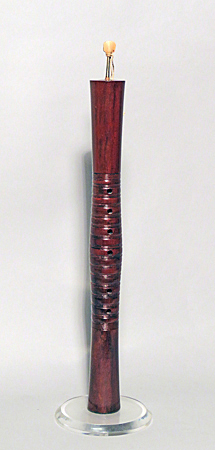
Owner: HWMC
Catalog#: 2AS-AERV-06
Reedpipes
Thailand ‘Pi Nai’
Thailand, Cambodia, Laos
Thailand, Cambodia, Laos
Wood, bamboo, metal
Mid 20th century
Length: 18.75 in (w/reed), Diameter: 1.75 in
Aerophones – Wind Instruments Proper – Reedpipes
The term pi is a generic name for double reed (four small pieces of dried palm leaf folded into two) instruments in Thailand, Laos, and Cambodia. In Thailand there are two main oboe types called pi, those with a mostly cylindrical bore – pi nai, which is seen here and those with a conical bore that resemble oboes of the Midddle East and Asia, also seen in this collection. The pi nai is a modification of the earlier instrument called pi nawk (a smaller rare version) and used for indoor performances of khon (dance dramas traditionally performed solely in the royal court by men in masks accompanied by narrators and a piphat ensemble). The pi nai is played using a technique called circular breathing.
This pi nai is made of a dark mahogany stained wood and has six fingerholes in the center with four holes together, then a space and two lower holes. The quadruple reed made of palm leaf is situated on a small brass tube, the bottom of which has thread wound around for attachment. The main body of the instrument is thick, heavy, and polished. It is carved on the outside with a rounded bulging middle that has incised rings only in the center and then flares out on both ends. In Cambodia this instrument is called a sralai.
Reference: “Pi,” David Morton/Terry E. Miller, “The Grove Dictionary of Musical Instruments,” 2nd ed., Vol. 4., Lawrence Libin, Editor in Chief. Oxford University Press.
